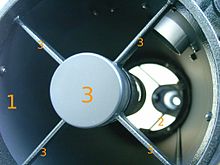Diffraction spike

Diffraction spikes are lines radiating from bright light sources in reflecting telescope images. They are artifacts caused by light diffracting around the support vanes of the secondary mirror. Refracting telescopes and their photographic images do not have the same problem.
Overview

In the vast majority of reflecting telescope designs, the secondary mirror has to be positioned at the central axis of the telescope and so has to be held by struts within the telescopes tube. No matter how fine these support rods are they diffract the incoming light from a subject star and this appears as diffraction spikes which are the Fourier transform of the support struts. The spikes represent a loss of light that could have been used to image the star.[1][2]
Although diffraction spikes can obscure parts of a photograph and are undesired in professional contexts, some amateur astronomers like the visual effect they give to bright stars - the "Star of Bethlehem" appearance - and even modify their refractors to exhibit the same effect,[3] or to assist with focusing when using a CCD.[4]
A small number of reflecting telescopes designs avoid diffraction spikes by placing the secondary mirror off-axis. Early off-axis designs such as the Herschelian and the Schiefspiegler telescopes have serious limitations such as astigmatism and long focal ratios, which make them useless for research. The brachymedial design by Ludwig Schupmann, which uses a combination of mirrors and lenses is able to correct chromatic aberration perfectly over a small area and designs based on the Schupmann brachymedial are currently used for research of double stars.
There are also a small number of off-axis unobstructed all-reflecting Anastigmats which give optically perfect images.
